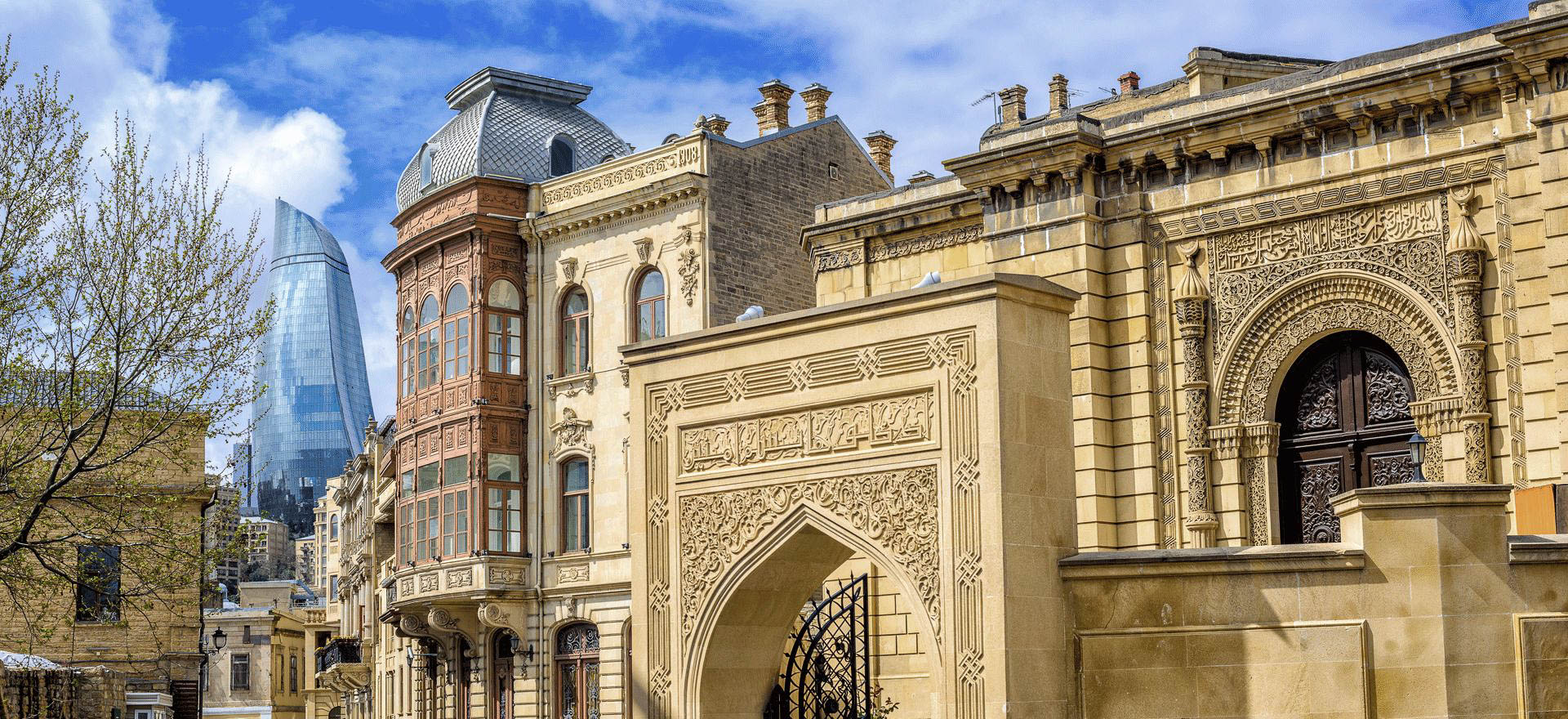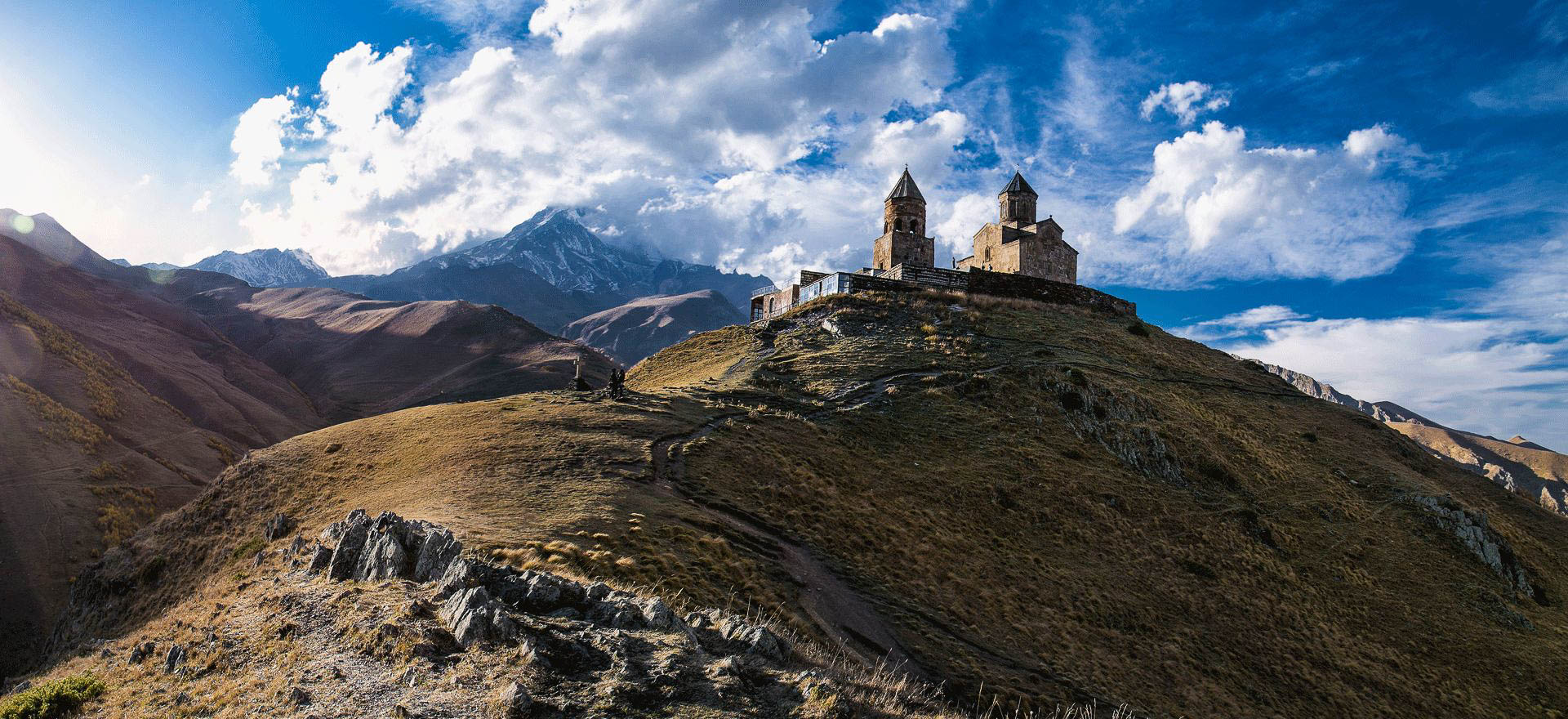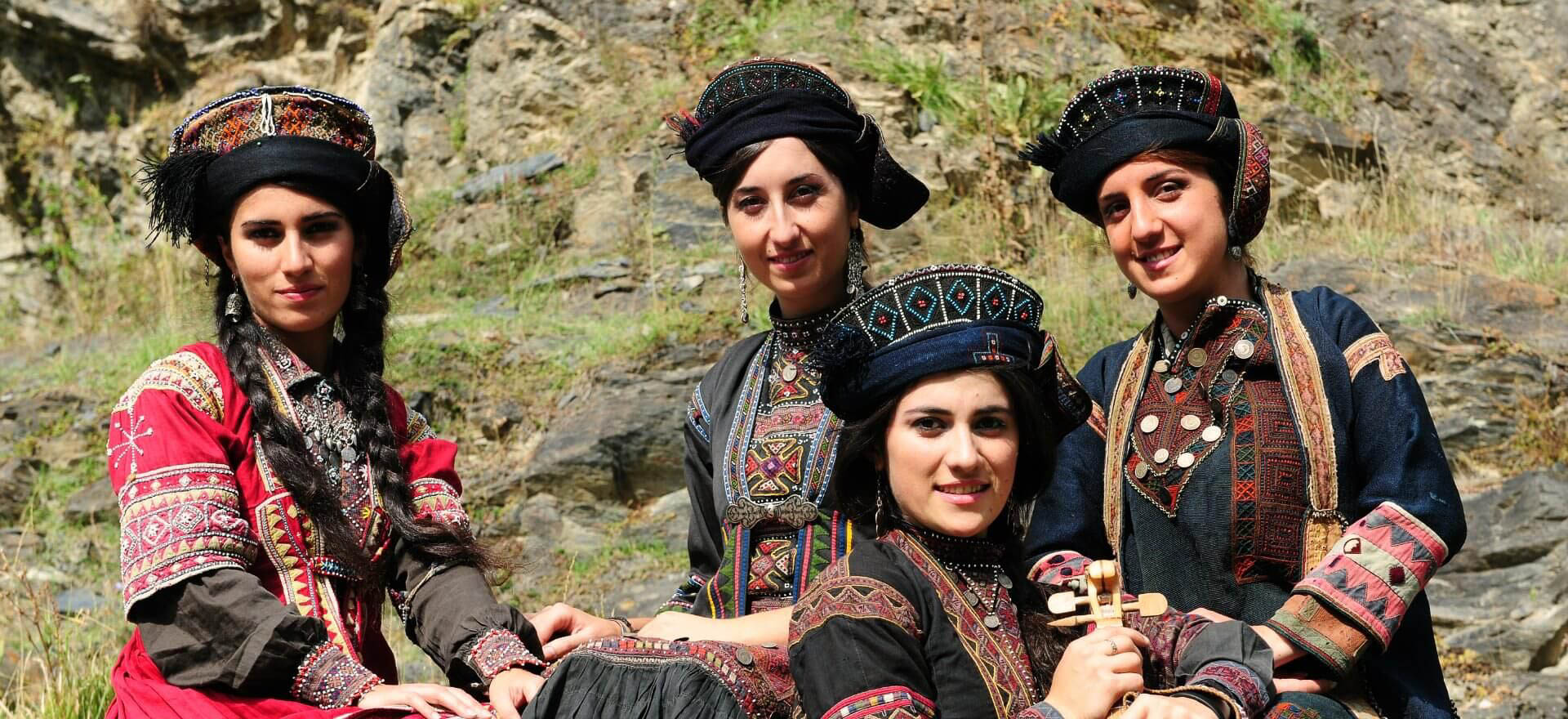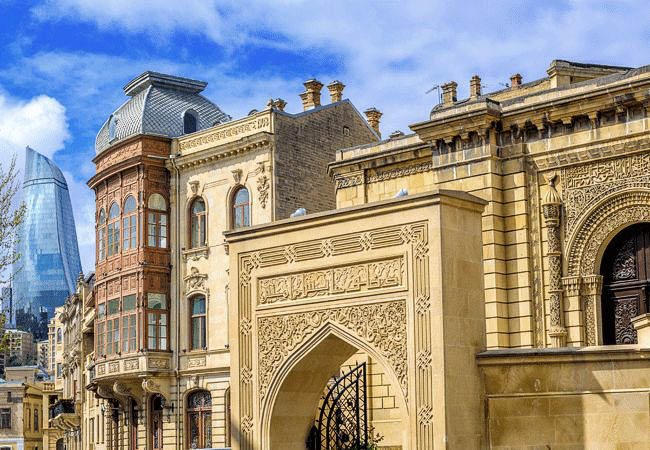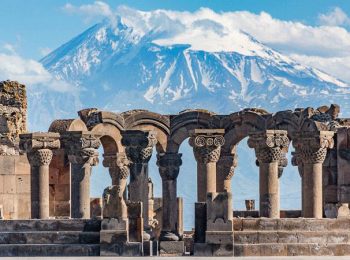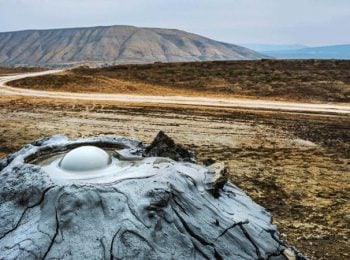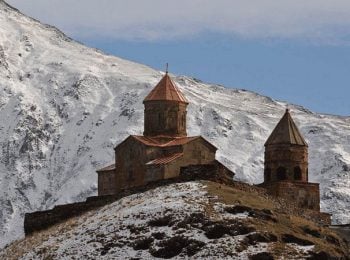Day 2 - Gobustan - Absheron Peninsula
Head out of Baku to Gobustan, known for its prehistoric rock art and unique mud volcanoes. From here, continue to the fascinating Absheron Peninsula with its ‘flaming mountain’, Yanardag, and the Temple of the Fire Worshippers at Ateshgah. Return to Baku for the evening. Overnight Central Park Hotel or similar. (B)
Day 3 - Baku
Spend today exploring Baku. We visit the National Museum and the historic quarter with buildings dating back to the 14th century including ancient caravanserais, mosques, the Palace of the Shirvanshahs and the enigmatic and mysterious Maiden’s Tower, among other sights. In the early evening, we visit the Hedar Aliyev Centre – a Zaha Hadid masterpiece. Overnight Central Park Hotel or similar. (B)
Day 4 - Guba – Xinaliq
Head north to the town of Guba. On the way we stop at the mountain of Beshbarmag, a natural fortress that is a local site for pilgrimage. From here we continue to the traditional mountain village of Xinaliq, to explore the area on foot and have lunch at a local family home. Nestled in the Caucasus Mountains, Xinaliq is Azerbaijan’s highest mountain village and its remote location and stunning scenery is a real highlight of the trip. Return to Guba for the evening. Overnight Terrace Hotel or similar. (BL)
Day 5 - Shamakha – Lahic - Qabala
Continue to Shamakha, visiting the 13th century mausoleum of Diri Baba in the village of Maraza en route. At Shamakha we visit the historic mosque, the seven tombed mausoleum of Yeddi Gumbaz, and the graveyard of the Shirvanshahs. From here we drive to the traditional village of Lahic with its old mosques, cobbled streets and craftsmen, and then continue to Qabala for the evening. Overnight Qabala Karavansarai or similar. (B)
Day 6 - Shekhi - Kish
Drive to Shekhi, one of the most interesting towns in Azerbaijan. After some free time to wander around at leisure, we visit the medieval fortress and the Khan’s Palace with its elaborate decorations, before heading to the nearby village of Kish, site of the oldest church in the Caucasus. Overnight Shekhi Palace Hotel or similar. (B)
Day 8 - Mtskheta – Kazbegi - Gudauri
Drive to Mtskheta, Georgia’s ancient capital where we visit the UNESCO listed Jvari Monastery and the striking Svetitskhoveli Cathedral. From here we head north along the Georgian Military Highway, crossing the Jvari Pass en route to Kazbegi, surrounded by the High Caucasus Mountains. Hike to the picturesque Sameba Church with views of Mt Kazbek in the background, then drive to Gudauri for the night. Overnight Hotel Alpina or similar. (BD)
Please note – there is the option to travel up to the Sameba Church by vehicle if you’d prefer not to do the hike.
Day 9 - Gori – Uplistiskhe – Kutaisi
Returning to the lowlands we visit Gori, the birthplace of Stalin, and the cave city of Uplistsikhe, dating back to the 7th century BC. Arriving in Kutaisi we visit the UNESCO listed Gelati Monastery, founded in the 12th century, and the Bagrati Cathedral. Overnight Argo Hotel or similar. (B)
Day 10 - Svaneti
Drive to the almost mythical region of Svaneti, high in the Caucasus Mountains and home to the Svans, perhaps Georgia’s most traditional ethnic group. We head to the town of Mestia, known for its typical architecture and dominated by defensive stone towers. Overnight Hotel Ushba or similar. (BD)
Day 11 - Svaneti
A full day exploring this stunning region. Drive to the village of Ushguli with its medieval buildings, watchtowers and the Lamaria church, and with a backdrop of Mt Shkhara, Georgia’s highest mountain. We explore the landscape on foot, taking easy walks nearby and also visit a local house to learn more about the unique customs of the Svan people. Return to Mestia for the night. Overnight Hotel Ushba or similar. (BD)
Day 12 - Tbilisi
Return to Tbilisi, arriving early evening. Overnight Sharden Hotel or similar. (B)
Day 13 - Tbilisi
Explore this interesting city and learn about its long and fascinating history. Visit the old town, the Metekhi Temple and the fortress of Narikala before heading to the impressive National Museum with its rich collection of cultural artefacts. We also explore the 11th century Sioni Cathedral and take in the sights of Rustaveli Avenue, Tbilisi’s main thoroughfare. Overnight Sharden Hotel or similar. (B)
Day 15 - Yerevan
Spend today exploring the charming city of Yerevan. We visit some of its key sites including Republic Square – the city’s most striking public space flanked by impressive buildings, the Matenadaran museum of ancient manuscripts, one of Yerevan’s most interesting and unique sights, and the Genocide Museum for an insight into Armenia’s recent history.
Day 16 - Khor Virap – Noravank
After breakfast drive to the monastery of Khor Virap, in a dramatic location with Mt Ararat in Turkey in the background. We explore the monastery, where it is claimed St Gregory was imprisoned for 13 years, then head to Noravank monastery, situated at the edge of the red rocks of Gnishik Gorge. We visit the oldest cave winery in Armenia and then take lunch in a local restaurant where we will also have a wine tasting. Later return to Yerevan. Overnight Hotel Imperial Palace or similar. (BL)
Day 17 - Sevan – Dilijan – Haghpat
This morning drive to the stunning Lake Sevan, a beautiful spot with the pretty Sevanavank monastery on its shores. From here continue to the town of Dilijan with its well preserved historic centre. Nearby live one of Armenia’s ethnic minorities, the Molokans, and we explore their villages for an insight into a rather unique culture. We spend the night in either Dilijan or nearby Dzoraget. Overnight Hotel Avan or similar. (BLD)
Day 18 - Echmiadzin – Zvartnots – Yerevan
We head back to Yerevan, stopping en route to visit a community of Yazidi people with their distinct customs and culture – another hidden side to Armenia. This afternoon we visit the complex of churches at Echmiadzin – a rather stunning ensemble – and the ruins of the temple of Zvartnots, before ending up in Yerevan for the night. Overnight Hotel Imperial Palace or similar. (BL)
Day 19 - Geghard – Garni - Yerevan
Drive to the monastery of Geghard, another of Armenia’s UNESCO sites and a fascinating place to explore. We then continue to the pagan temple of Garni, very different from other monuments here and perched on the edge of a gorge. We descend into the gorge then drive to a local village, where we have lunch in a village house and can learn about Armenian cuisine as we watch and help (if you choose) the meal preparation. Before arriving back in Yerevan, we stop at a brandy distillery to taste one of Armenia’s most famous products. Overnight Hotel Imperial Palace or similar. (BLD)
Day 20 - Yerevan
Transfer to the airport for your onward flight. (B)
Please note that this trip is a three week tour travelling overland through Azerbaijan, Georgia and Armenia and so while some people will be starting their tour in Baku and travelling for the entire three weeks, others will be starting their trip in Tbilisi or Yerevan and/or ending in Baku or Tbilisi.
What's included?
What's not included?
Visas
All travellers will require a visa to enter Azerbaijan, which must be obtained before travel. Should you require an invitation letter or an E-Visa, we can provide these for you. If you’d like us to arrange your E-Visa, the cost is £50.00.
Americans, Australians and most European nationalities, including British citizens, no longer require a visa to enter Georgia.
Most European nationalities, including British, American and Australian citizens, no longer require a visa to enter Armenia. Canadian citizens must obtain an e-visa in advance, via the following site: https://evisa.mfa.am
Visa regulations can change however and so we recommend that you contact your nearest embassy for the most up to date information.
Health and vaccinations
We are not medically qualified and so we recommend that you speak to your doctor or nearest health professional for advice concerning recommended vaccinations. However, there are no compulsory vaccinations needed to enter either country. For more advice on vaccinations you can also visit https://travelhealthpro.org.uk/countries.
If you have any physical limitations that might impact your ability to participate in the planned tour activities, it’s essential that you make us aware as soon as possible so that we can discuss this with you.
Insurance
It is a condition of joining our tours that you have suitable travel insurance in place, and we cannot accept travellers without insurance. All policies differ in terms of what they will cover, but as a minimum you need medical and health cover, which will cover you for the whole time that you are away. Most policies will also include cancellation cover, which will cover you if an unforeseen circumstance obliges you to cancel your trip. We recommend that you obtain your insurance as soon as you book your trip.
Please note that government travel warnings often affect the validity of your travel insurance, and you should check this with your insurance company.
From 1 June 2024, the Georgian authorities have also made it compulsory to obtain travel insurance when travelling there, and you may be asked for proof of this upon arrival.
Money
The local currency in Azerbaijan is the manat. Georgia’s currency is the lari, and in Armenia it’s the dram. It’s unlikely you will be able to obtain these from your local exchange bureau. We recommend taking either US dollars or Euros to exchange – British pounds will be much harder to change.
Changing money is fairly simple – many hotels will offer this service and there are also banks and exchange bureaus in larger towns. Your guide will be able to advise of the best option. In the capital cities there are also ATMs, which accept foreign cards, although don’t count on these always working. Credit cards are not used as widely here as they are in other European countries, so you should only think of this as a back up rather than the main source of obtaining money.
Local conditions
When travelling in countries such as these, which are comparatively underdeveloped in places, it’s important to understand that things won’t always work here as we’re used to them working at home. Travelling in underdeveloped and untouristed destinations requires both patience and a sense of humour. There may be problems with infrastructure, attitudes may be different, and maintenance may not be as high a standard as we would always like, but this is very much part and parcel of travelling in such a place. We aim to resolve any issues as quickly as possible, and thank you for your patience.
Travel advice
We keep a very close eye on the travel advice issued by the UK Foreign and Commonwealth Office so that we can keep you up to date with any warnings. At the time of writing there are no warnings against travel to the parts of Georgia, Armenia or Azerbaijan that we visit.
This relates to advice from the British government – other nationalities need to check the stance of their own governments.
Please note that the information contained above is highly susceptible to change, and while we endeavour to keep up to date we recommend that you use this as a guide only. Should you have any questions, please don’t hesitate to contact us.
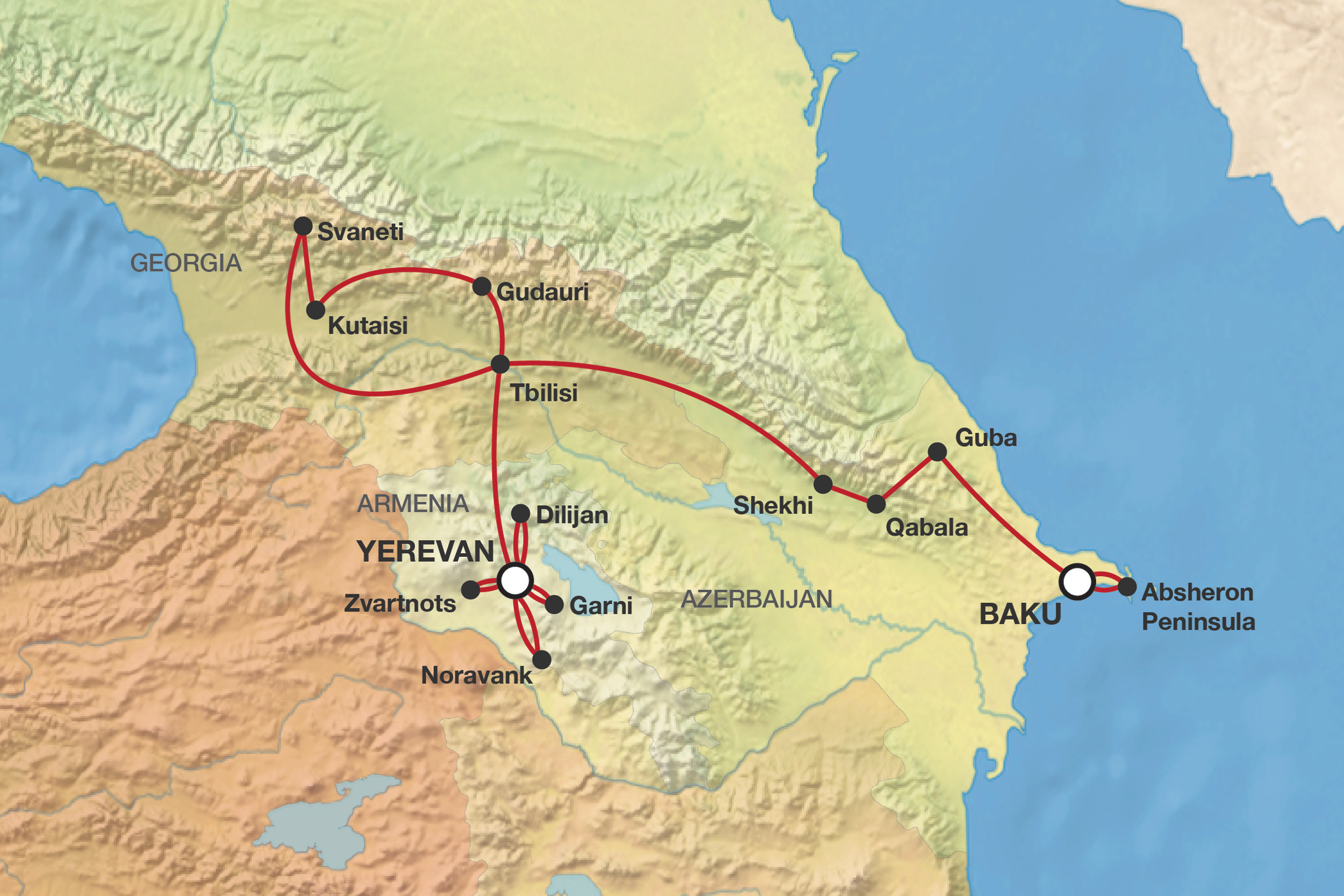
You may also like…
- Prices from£6,749EXPLORETurkmenistan, Kyrgyzstan, Kazakhstan, Uzbekistan, TajikistanCentral Asia Encompassed
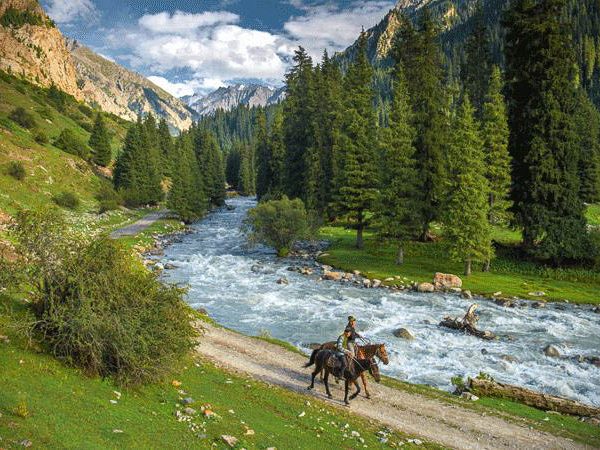
Central Asia Encompassed
- Prices from£3,199EXPLOREUzbekistan, Tajikistan, TurkmenistanSilk Road Explorer
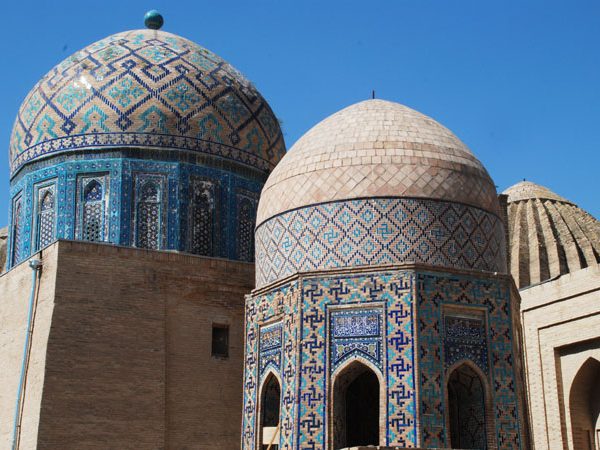
Silk Road Explorer
- Prices from£3,599EXPLORESerbia, Montenegro, Croatia, BosniaHighlights of the Balkans
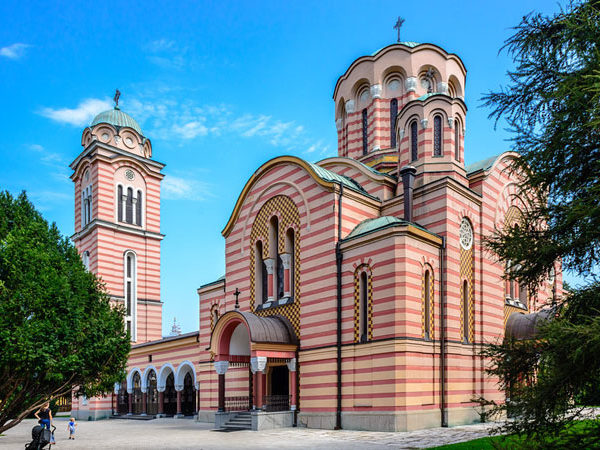
Highlights of the Balkans

